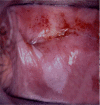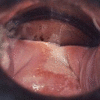The European Society of Gynaecological Oncology (ESGO), the International Society for the Study of Vulvovaginal Disease (ISSVD), the European College for the Study of Vulval Disease (ECSVD), and the European Federation for Colposcopy (EFC) Consensus Statement on the Management of Vaginal Intraepithelial Neoplasia
- PMID: 36951985
- PMCID: PMC10026974
- DOI: 10.1097/LGT.0000000000000732
The European Society of Gynaecological Oncology (ESGO), the International Society for the Study of Vulvovaginal Disease (ISSVD), the European College for the Study of Vulval Disease (ECSVD), and the European Federation for Colposcopy (EFC) Consensus Statement on the Management of Vaginal Intraepithelial Neoplasia
Abstract
The European Society of Gynaecological Oncology (ESGO), the International Society for the Study of Vulvovaginal Disease (ISSVD), the European College for the Study of Vulval Disease (ECSVD), and the European Federation for Colposcopy (EFC) developed consensus statements on pre-invasive vulvar lesions in order to improve the quality of care for patients with vaginal intraepithelial neoplasia (VaIN). The management of VaIN varies according to the grade of the lesion: VaIN 1 (low grade vaginal squamous intraepithelial lesions (SIL)) can be subjected to follow-up, while VaIN 2-3 (high-grade vaginal SIL) should be treated. Treatment needs individualization according to the patient's characteristics, disease extension and previous therapeutic procedures. Surgical excision is the mainstay of treatment and should be performed if invasion cannot be excluded. Total vaginectomy is used only in highly selected cases of extensive and persistent disease. Carbon dioxide (CO2) laser may be used as both an ablation method and an excisional one. Reported cure rates after laser excision and laser ablation are similar. Topical agents are useful for persistent, multifocal lesions or for patients who cannot undergo surgical treatment. Imiquimod was associated with the lowest recurrence rate, highest human papillomavirus (HPV) clearance, and can be considered the best topical approach. Trichloroacetic acid and 5-fluorouracil are historical options and should be discouraged. For VaIN after hysterectomy for cervical intraepithelial neoplasia (CIN) 3, laser vaporization and topical agents are not the best options, since they cannot reach epithelium buried in the vaginal scar. In these cases surgical options are preferable. Brachytherapy has a high overall success rate but due to late side effects should be reserved for poor surgical candidates, having multifocal disease, and with failed prior treatments. VaIN tends to recur and ensuring patient adherence to close follow-up visits is of the utmost importance. The first evaluation should be performed at 6 months with cytology and an HPV test during 2 years and annually thereafter. The implementation of vaccination against HPV infection is expected to contribute to the prevention of VaIN and thus cancer of the vagina. The effects of treatment can have an impact on quality of life and result in psychological and psychosexual issues which should be addressed. Patients with VaIN need clear and up-to-date information on a range of treatment options including risks and benefits, as well as the need for follow-up and the risk of recurrence.
Copyright © 2023 ESGO, ISSVD, EFC, ECSVD. Published by Wolters Kluwer Health, Inc. on behalf of the ASCCP.
Conflict of interest statement
The authors have declared they have no conflicts of interest.
Figures





Similar articles
-
The European Society of Gynaecological Oncology (ESGO), the International Society for the Study of Vulvovaginal Disease (ISSVD), the European College for the Study of Vulval Disease (ECSVD), and the European Federation for Colposcopy (EFC) consensus statement on the management of vaginal intraepithelial neoplasia.Int J Gynecol Cancer. 2023 Apr 3;33(4):446-461. doi: 10.1136/ijgc-2022-004213. Int J Gynecol Cancer. 2023. PMID: 36958755 Free PMC article. Review.
-
The European Society of Gynaecological Oncology (ESGO), the International Society for the Study of Vulvovaginal Disease (ISSVD), the European College for the Study of Vulval Disease (ECSVD) and the European Federation for Colposcopy (EFC) consensus statements on pre-invasive vulvar lesions.Int J Gynecol Cancer. 2022 Jul 4;32(7):830-845. doi: 10.1136/ijgc-2021-003262. Int J Gynecol Cancer. 2022. PMID: 35728950 Free PMC article.
-
The European Society of Gynaecological Oncology (ESGO), the International Society for the Study of Vulvovaginal Disease (ISSVD), the European College for the Study of Vulval Disease (ECSVD) and the European Federation for Colposcopy (EFC) Consensus Statements on Pre-invasive Vulvar Lesions.J Low Genit Tract Dis. 2022 Jul 1;26(3):229-244. doi: 10.1097/LGT.0000000000000683. Epub 2022 Jun 21. J Low Genit Tract Dis. 2022. PMID: 35763611 Free PMC article.
-
Clinical presentation, treatment, and outcomes associated with vaginal intraepithelial neoplasia: A retrospective study of 118 patients.J Obstet Gynaecol Res. 2021 May;47(5):1624-1630. doi: 10.1111/jog.14733. Epub 2021 Mar 23. J Obstet Gynaecol Res. 2021. PMID: 33754436 Review.
-
Vaginal intraepithelial neoplasia in patients after total hysterectomy.Curr Probl Cancer. 2021 Jun;45(3):100687. doi: 10.1016/j.currproblcancer.2020.100687. Epub 2020 Dec 4. Curr Probl Cancer. 2021. PMID: 33309077
Cited by
-
Chemical Peeling Therapy Using Phenol for the Cervico-Vaginal Intraepithelial Neoplasia.Viruses. 2023 Nov 7;15(11):2219. doi: 10.3390/v15112219. Viruses. 2023. PMID: 38005896 Free PMC article.
-
Laser Therapy in Heavily Treated Oncological Patients Improves Vaginal Health Parameters.Cancers (Basel). 2024 Jul 31;16(15):2722. doi: 10.3390/cancers16152722. Cancers (Basel). 2024. PMID: 39123449 Free PMC article.
-
Concomitant Cervical and Anal Screening for Human Papilloma Virus (HPV): Worth the Effort or a Waste of Time?Cancers (Basel). 2024 Oct 19;16(20):3534. doi: 10.3390/cancers16203534. Cancers (Basel). 2024. PMID: 39456627 Free PMC article.
-
Unveiling Hidden Risks: Intentional Molecular Screening for Sexually Transmitted Infections and Vaginosis Pathogens in Patients Who Have Been Exclusively Tested for Human Papillomavirus Genotyping.Microorganisms. 2023 Oct 30;11(11):2661. doi: 10.3390/microorganisms11112661. Microorganisms. 2023. PMID: 38004673 Free PMC article.
-
Imiquimod for Anal High Grade Intraepithelial Neoplasia: A Systematic Review.Curr Oncol Rep. 2025 Jul;27(7):833-843. doi: 10.1007/s11912-025-01675-1. Epub 2025 May 19. Curr Oncol Rep. 2025. PMID: 40387973 Free PMC article.
References
-
- Preti M Joura E Vieira-Baptista P, et al. . The European Society of Gynaecological Oncology (ESGO), the International Society for the Study of Vulvovaginal Disease (ISSVD), the European College for the Study of Vulval Disease (ECSVD) and the European Federation for Colposcopy (EFC) consensus statements on pre-invasive vulvar lesions. Int J Gynecol Cancer 2022;32:830–785. - PMC - PubMed
-
- Darragh TM Colgan TJ Cox JT, et al. . The lower anogenital squamous terminology standardization project for HPV-associated lesions: background and consensus recommendations from the College of American Pathologists and the American Society for Colposcopy and Cervical Pathology. J Low Genit Tract Dis 2012;16:205–163. - PubMed
-
- Chiu T-L Jones RW, et al. . Multifocal multicentric squamous cell carcinomas arising in vulvovaginal lichen planus. J Low Genit Tract Dis 2011;15:246–239. - PubMed
-
- Regauer S Reich O Kashofer K, et al. . HPV-negative squamous cell carcinomas of the cervix with special focus on intraepithelial precursor lesions. Am J Surg Pathol 2022;46:147–89. - PubMed
-
- WHO Classification of Tumors Editorial Board . Female genital tumors, WHO classification of tumors, 5th edition, volume 4; 2020.

